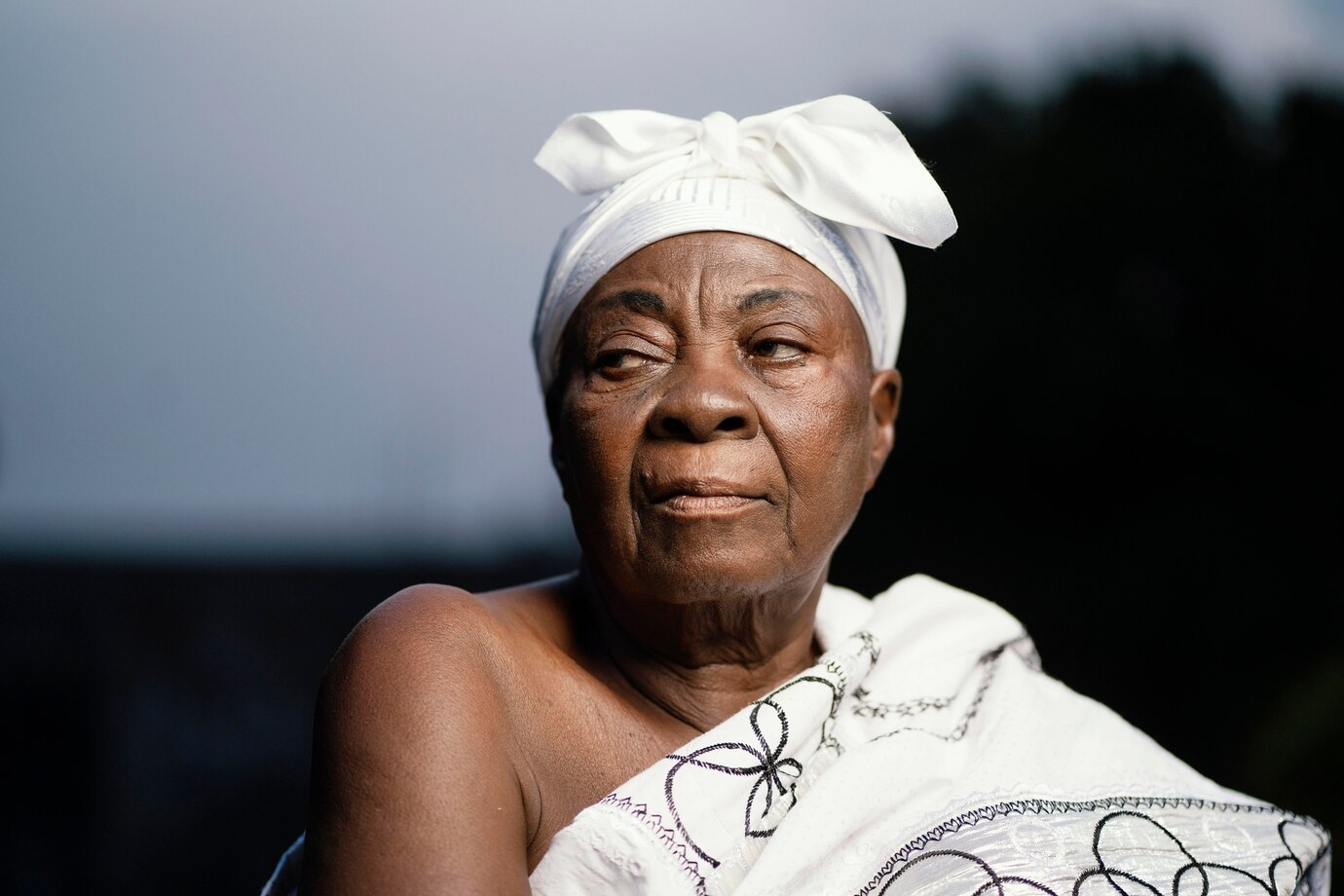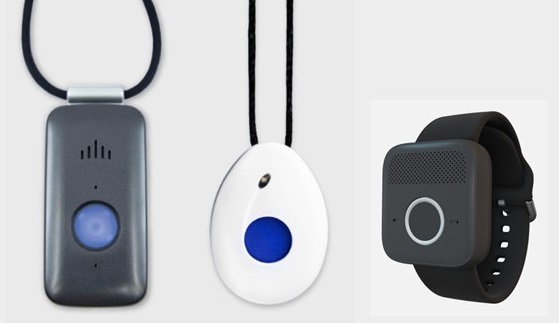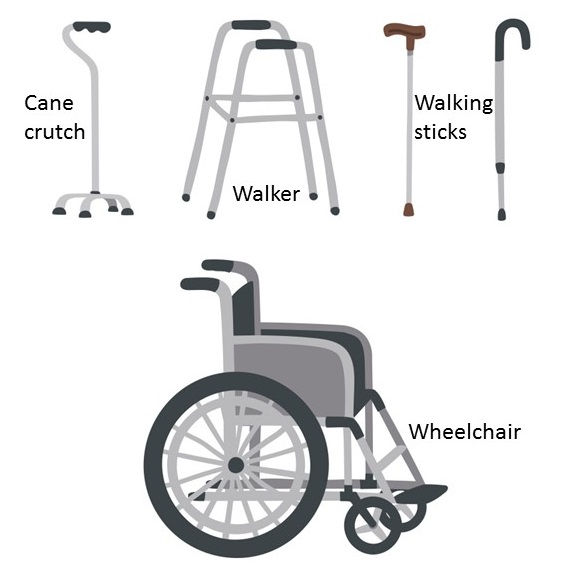By: Rukhsar Jabbar. M.Sc. Physiotherapy. Freelance Health Writer. Medical review by The DLHA Team

Portrait of an African elderly woman. Image credit: Freepik.
Globally, life expectancy is rising, with sub-Saharan Africa predicted to see the largest increases. The older adult population (those 65 and over) in the region is expected to rise from 32 million in 2019 to 101 million in 2050, a 218% increase. [1]
Ageing is linked to a decline in the body's capacity for both physical and mental tasks, as well as an increased risk of developing age-related illnesses. An ageing body's physical degradation leads to a decline in lower extremity muscular strength and coordination and a reduction in walking efficiency and balance control.
These deficits increase the elderly's risk of falling in addition to their decreasing learning abilities. Approximately thirty percent of individuals who are 65 or older, the traditional cutoff age for being considered elderly, fall on average once a year. Lowering the risk of falling among this demographic is essential to preventing more repercussions from occurring. It is known that inactivity will hasten the deterioration of physiological processes that impair balance regulation. [2]
Older adults who experience falls are more likely to experience medical conditions (morbidity) and a rise in death rate (mortality). After the age of 60, there is a steady increase in the frequency and severity of falls as well as the seriousness of the consequences that follow a fall. Even in cases where an older adult's fall does not cause a major injury, it can nevertheless have a significant psychological impact on them.
The purpose of this blog is to -
Falls are a serious issue for older adults, ranking as the ninth leading cause of death for those 65 and older, according to the CDC. In Africa, about 23% of people over 60 have experienced a fall. These falls come with a heavy financial burden, making up 27% of hospital expenses. Unfortunately, this problem is likely to worsen with more fractures and higher healthcare costs.
In Africa, the overall rate of falls among older adults is 24.2%, a significant rise from the 17.3% reported in earlier studies from Western countries. The difference in rates could be due to factors like study design, culture, and ethnicity. Still, research shows that the percentage of falls generally ranges from 11% to 25%. [3]
When designing and executing fall prevention intervention programs, it's critical to assess older adults who are at risk of falling and identify potential risk factors and the situations that lead up to a fall. [4]
The risk factors for falls in the elderly can be grouped into two broad classes: Controllable and Non-controllable.
These are directly within the control of the individual or their caregivers to manage.[5] (See table 1) They include:
Extrinsic controllable factors are those associated with the living environment, e.g., inadequate lighting, loose carpets, slippery flooring, etc.
Intrinsic controllable factors are those associated within the individual, e.g., underlying medical status, medications, progressing age, etc.
Situational controllable factors include dynamic conditions that may distract the focus of the individual while walking, e.g., Multitasking, being in a hurry to do things, talking while walking, etc. (See table 1)
Table 1: Showing categories of controllable risk factors for falls in the elderly. Click on image to enlarge.
These are factors outside the direct control of the individual or their caregivers. They include:
These factors put older people especially in African countries at increasing health and social disadvantages, including the risk of falls in and outside the home. The COVID-19 epidemic exposed a large number of people, especially older persons, to a variety of risks as they lacked adequate social protection measures. Given the significant roles that the elderly people of Africa play in their families, communities and societies at large, they will need specific and targeted environmental and social welfare assistance and support from their respective governments to meet demands for improved quality of life that are outside their direct control to achieve. [6]
Stumbling, tripping, and slipping account for most falls among the elderly. On the other hand, fall risks vary according to their living arrangement. Residents may trip and fall because of inadequate lighting, tangles in loose carpets, electrical cords, or both.10% of these falls result in serious injuries, compared to 30% to 50% that only cause minor injuries. [4]
Hip fractures cause about 1% of all falls in the elderly and are associated with a high risk of post-fall morbidity and death. An individual's fragility, not their age, determines the severity of an injury and its consequence. The term frailty refers to a reduction in an older person's physiologic reserve, such as their capacity to carry a grocery bag or climb a flight of stairs. An elderly person who is feeble is more likely to fall and get injuries from a fall. [5]
Physical activity plays a key role in the prevention of falls as it limits the loss of muscle mass and strength and stimulates postural control after injury. It also improves recovery.
Physical activity guidelines for seniors recommend muscle-strengthening activity performed on two or more days per week with at least 150 minutes per week of moderate-intensity aerobic exercise. Such physical activity stimulates reaction time, cognitive performance, sensory stimulation, and social interaction. This contributes to improving adaptive structural and functional changes in the brain (neuroplasticity).
There are effective ways to lower the risk of falling, including balance training and leg strength training. Since balance is necessary for standing and moving, postural training which promotes stability should also play a significant part in reducing the risk of falls. [7]
Exercise regimens, encompassing resistance, tai chi, endurance, platform balance, and flexibility, all contribute to the prevention of falls. [8]
The ancient martial art of tai chi is characterised by slow, rhythmic motions, such as trunk rotation, weight shifting, coordination, and a progressive constriction of the lower extremity stance. It has become known as an excellent kind of exercise for senior citizens.
Research indicates that tai chi enhances postural stability more than other forms of training. It also provides several advantages for the heart and musculoskeletal system. Unfortunately, patients having a history of fractures should not practise tai chi. [8]
Fall prevention strategies also include balance-focused exercises, such as (1) heel-to-toe walking and (2) one-foot standing, in addition to coordination drills. [8]
Home modifications is defined as "changes made to the home environment to help people to be more independent and safe in their own homes and reduce any risk of injury to their carers and care workers". Due to their growing recognition as an effective policy and practice response to help fragile, older people and people living with disabilities to remain at home, house modifications offer a unique opportunity to test directly how housing policies impact health and care. [9]
The purpose and style of home adaptations vary widely, and they can involve significant structural alterations such as the addition of;
They may also consist of small, non-structural improvements like grab rails and handrails, as well as assistive equipment installed inside or outside the home. [9]
3. Healthcare management
The evaluation of fundamental ADLs ought to encompass activities such as washing, using the lavatory, dressing, eating, grooming, and walking.
The evaluation of instrumental ADLs ought to encompass activities such as grocery shopping, cooking, handling personal money, using a phone, doing laundry, cleaning, and travelling. Enquiring from the elderly about any challenges they may have finishing these tasks can yield important insights. [8]
Given the strong culture of community and collectiveness in most African settings, it is no wonder that when the elderly show limits in their physical, mental, or learning abilities, family members, friends, partners, or neighbours, step in to offer assistance, usually without compensation.
This is often at a great cost to the caregiving parties due to the lack of social insurance as well as public structures and provisions for assistance and safety net for the elderly in most coutries in Africa. [10]
In a few cases, the elderly with limited family to care for them are placed in "old people's home", which are often funded by a combination of charitable contributions from well-meaning community members and some limited local government contributions.
Falls among older adults are a serious concern, so wearable technology for fall alerts is a popular area of research. At the same time, new technologies are being developed to help caregivers and seniors prevent falls before they happen or notify them promptly when it happens. One area getting a lot of attention is fall alert systems. These systems, which are mainly accessible to the well-off who can afford them, aim to help older adults stay independent and reduce their fear of falling by ensuring that help will be available if they do fall. [11]

Varieties of emergency fall and medical alert devices for the elderly
Also, smartphone-based system can detect falls in real time, which is helpful since smartphones are widely used. With an app-based fall detection system, users won’t face many issues like installation or battery life problems. This system also uses the phone's connectivity to quickly alert emergency services or a caregiver if a fall happens. Getting help promptly after a fall can reduce serious problems like pneumonia, head injuries, fractures, dehydration, and even the fear of falling. [12]
A primary reason for mobility device prescription is to reduce the risk of falling while increasing mobility. Mobility devices, including canes, walkers, and wheelchairs are often prescribed for and used by older adults to compensate for decrements in balance, coordination, sensation, strength, and increased risk for falls. While sometimes prescribed by a physician and dispensed under guidance from a physical therapist, these devices are also available for purchase by the general public. [13]

Examples of fall prevention assistive devices for the elderly.
Click here to learn more information about assistive devices for the elderly.
Table 2 provides a summary of fall prevention interventions and steps that family members, carers and community social services should consider in reducing the risk of falls in elderly Africans in and outside their homes.
Table 2: Details of plan of action for prevention of falls in the elderly. Click on image to enlarge.
It's important to recognise extrinsic variables like poor footwear and environmental dangers as well as intrinsic aspects like age-related physical changes and chronic diseases when it comes to fall prevention among older Africans. Participating in regular physical activity, making home adaptations, efficiently managing healthcare, and utilising social and community assistance are all excellent fall prevention techniques. We can make senior living environments safer by increasing awareness and fusing old values with contemporary methods.
Fall prevention requires a proactive strategy. It is the responsibility of individuals, families, and communities to work together to safeguard African seniors from falls. When preventative measures are broadly implemented, the frequency of falls in older Africans can be greatly lowered with resulting improvements in quality of life.
1. Akinrolie O, Iwuagwu AO, Kalu ME, Rayner D, Oyinlola O, Ezulike CD, et al. Longitudinal studies of aging in sub-saharan africa: review, limitations, and recommendations in preparation of projected aging population. Innov Aging. 2024 Jan 23;8(4):igae002. doi: 10.1093/geroni/igae002. Available from here
2. Thomas E, Battaglia G, Patti A, Brusa J, Leonardi V, Palma A, et al. Physical activity programs for balance and fall prevention in elderly: A systematic review. Medicine. 2019 Jul;98(27). doi: 10.1097/MD.0000000000016218. Available from here.
3. Fanta S, Amir M, Riau DP. The role of protocols in facilitating the activities of regional heads secretariat at the central buton district. Int J Sci Res Sci Eng Technol. 2024 Mar 3;11(2):04–9. doi: 10.32628/IJSRSET2411135. Available from here.
4. Kalula SZ, Ferreira M, Swingler GH, Badri M. Risk factors for falls in older adults in a South African Urban Community. BMC Geriatr 2016 Feb 24;16:51. doi: 10.1186/s12877-016-0212-7. Available from here.
5. Vaishya R, Vaish A. Falls in older adults are serious. Indian J Orthop [Internet]. 2020 Jan 24;54(1):69–74. doi: 10.1007/s43465-019-00037-x. Available from here.
6. Dhemba J. Challenges faced by older persons in Eastern and Southern Africa and implications for social work practice. Social Work & Society. 2023;21(2). Available from here.
7. Patti A, Zangla D, Sahin FN, Cataldi S, Lavanco G, Palma A, et al. Physical exercise and prevention of falls. Effects of a Pilates training method compared with a general physical activity program. Medicine (Baltimore). 2021 Apr 2;100 (13):e25289. doi: 10.1097/MD.0000000000025289. Available from here.
8. Appeadu MK, Bordoni B. Falls and fall prevention in older adults. In: StatPearls [Internet]. Treasure Island (FL): StatPearls Publishing; 2024 [cited 2024 Jul 31]. Available from here.
9. Carnemolla P, Bridge C. Housing design and community care: how home modifications reduce care needs of older people and people with disability. Int J Environ Res Public Health 2019 Jun 1;16(11):1951. doi: 10.3390/ijerph16111951. Available from here.
10. Schulz R, Beach SR, Czaja SJ, Martire LM, Monin JK. Family caregiving for older adults. Annu Rev Psychol [Internet]. 2020 Jan 4. 71(1):635–59. doi: 10.1146/annurev-psych-010419-050754. Available from here.
11. Vollmer Dahlke D, Lee S, Smith ML, Shubert T, Popovich S, Ory MG. Attitudes toward technology and use of fall alert wearables in caregiving: survey study. JMIR Aging. 2021 Jan. 27. 4(1):e23381. doi: 10.2196/23381. Available from here.
12. Harari Y, Shawen N, Mummidisetty CK, Albert MV, Kording KP, Jayaraman A. A smartphone-based online system for fall detection with alert notifications and contextual information of real-life falls. J Neuroeng Rehabil. 2021 Aug 10;18 (1):124. doi: 10.1186/s12984-021-00918-z. Available from here.
13. Gell NM, Wallace RB, LaCroix AZ, Mroz TM, Patel KV. Mobility device use among older adults and incidence of falls and worry about falling: findings from the 2011–2012 national health and aging trends study. J Am Geriatr Soc. 2015 May;63(5):853–9. doi: 10.1111/jgs.13393. Available from here.
Published: August 12, 2024
© 2024. Datelinehealth Africa Inc. All rights reserved.
Permission is given to copy, use and share content for non-commercial purposes without alteration or modification and subject to source attribution.
DATELINEHEALTH AFRICA INC., is a digital publisher for informational and educational purposes and does not offer personal medical care and advice. If you have a medical problem needing routine or emergency attention, call your doctor or local emergency services immediately, or visit the nearest emergency room or the nearest hospital. You should consult your professional healthcare provider before starting any nutrition, diet, exercise, fitness, medical or wellness program mentioned or referenced in the DatelinehealthAfrica website. Click here for more disclaimer notice.